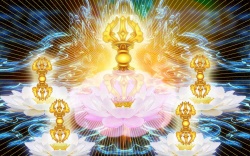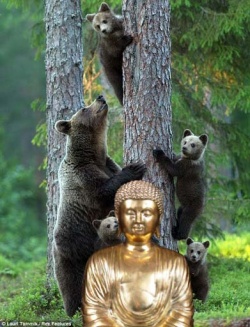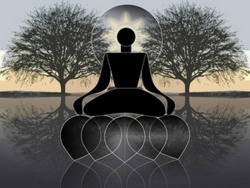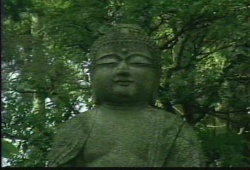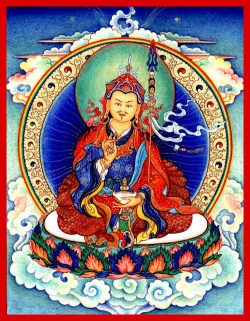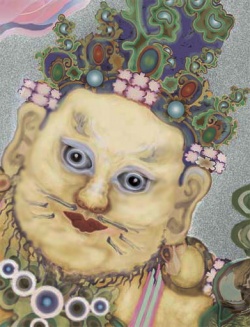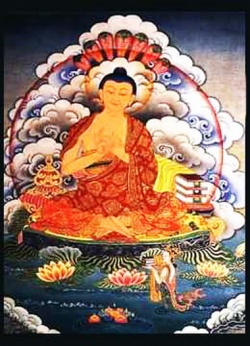Effective Tantra Practice II
We started our discussion of how to make our tantra practice effective or more effective. And we saw that the most fundamental thing to start with is to understand what tantra is and what is the essential point of tantra practice – how does it work. And we saw that tantra means an everlasting stream of continuity. And, on a basis level, that’s referring to all our Buddha-nature factors, which are innate features of our mental continuum. “Innate” means that they arise simultaneously with each moment of our mental activity, each moment of our mental continuum; that’s what the word “innate” means. Right? That word “innate” literally is “simultaneously arising”; it arises simultaneously with the mental continuum. And the resultant level is when all these Buddha-nature factors are working at their fullest capacity, their fullest ability; in other words, the enlightened state of a Buddha, which also will go on forever.
So the basic Buddha-nature factors are on the basis level – no beginning, no end – but the obscurations which obscure it, which limit the capacity of these factors from working at their fullest efficiency – although they have no beginning, they can come to an end because these obscuring factors are not based on reality or understanding, and so their basis, unawareness, can be replaced with correct awareness. And when we are able to stay with correct understanding, without a break, then these disturbing factors, these obscuring factors will never arise again. And then these Buddha-nature factors will no longer be limited; they will work at their fullest level and they will continue going on forever.
And it’s very important to be quite convinced of these Buddha-nature factors in order to practice tantra effectively, because without this conviction then it’s very easy to fall sometimes into low self-esteem. We think that we can’t really accomplish anything, that “I’m not good enough,” etc. On the other hand, if we go to the opposite extreme of thinking that “I’m already a Buddha, I don’t really have to do anything in order to be a Buddha,” then we overestimate ourselves, we overestimate these Buddha-nature factors; and of course, since we’re not enlightened yet, we make many, many mistakes, being completely filled with arrogance, false pride.
Now we also have the pathway tantra. We spoke about the basis, the result, now we also have the path. And this pathway tantra is practiced with these Buddha-figures. These Buddha-figures aren’t something that start as babies – have to be conceived, and start as babies, and grow. They’re something which remains always available forever. So, in that sense, they’re a tantra. And we saw that tantra practice entails imagining ourselves – at first imagining, but then eventually transforming ourselves into these Buddha-figures. And, at the same time, starting with imagination, we imagine that we have the mind of a Buddha, so all the understanding, the love, compassion, etc. of a Buddha. And we also imagine that we have the speech of a Buddha, so we have mantras that are able to communicate perfectly with everyone. And we imagine that the way that we are acting is benefiting all beings, so we imagine that lights go out and benefit everyone – lights go out from us, from our heart.
And, in order to work with these Buddha-figures, which have many arms and faces – so they help us to keep in mind all the things that they represent, all the qualities of a Buddha – in order to work with that, we need to understand the reality of what’s going on, which entails quite a lot, actually.
When we talk about “me,” the person, self, the “me,” everybody’s “me,” individual “me,” it’s something which is labeled on what’s known as our aggregate factors, so the body, mind, speech, emotions, everything that’s going on in each moment. And so, in terms of all these factors – which are changing at different rates, every moment of our continuum, lifetime after lifetime – there’s a way to put that all together: we refer to it with the word or the concept “me.” And that word or concept “me” actually does refer to something, the actual conventional “me,” even though there’s no solid findable “me” with a big line around it, sitting somewhere in my head, talking – the voice in my head – and manipulating, controlling what’s happening or just observing it.
So we do exist; there is a “me,” but that’s the conventional “me.” But what doesn’t exist is the false “me” – the false “me” being what could correspond to a word, which would be something just sort of sitting there, with a big line around it – “me” – as if it were encapsulated in plastic, isolated from everything else, never changing, some sort of solid monad type of thing. So, anyway, that’s the false “me.”
So we have this conventional “me” that is labeled, we say, or imputed, on all these changing factors of our experience. So, among those changing factors of our experience in every moment, we have these Buddha-nature features, don’t we? And remember what we were referring to with these Buddha-nature factors were the network of positive force or positive potential that we have, and some network of deep awareness – the way that the mind actually works and knows things by taking in information and putting things together, etc. And we have some sort of body, some sort of appearance; energy is going out: there’s some sort of communicative ability. There are all the mental faculties of understanding, knowing, feeling different levels of happiness, unhappiness, emotions, etc. Positive emotions here, we’re talking about – in terms of Buddha-nature factors – love, compassion, warmth.
And in terms of body, the appearance that we have – our ordinary form – that’s something which arises from these karmic potentials. And so our mental continuum will operate in some sort of physical body, one lifetime or another – different level of physical bodies – and that will be the appearance that we will have. Now an ordinary samsaric appearance – an appearance as a human being, or a dog, or a ghost, or cockroach, whatever – that is going to be generated by these obscuring factors.
So part of each moment of our experience is not only these Buddha-nature factors, but also unawareness, various types of disturbing emotions, and so on – karmic impulses, etc., positive and negative karmic potentials – that’s going to be there in each moment. So “me” is labeled on all of this, in each moment. “Me” is referring to the actual conventional “me” that is based on each moment of this, of our continuing experience, which has these Buddha-nature factors and also these obscuring factors. And because of these obscuring factors – the unawareness and the disturbing emotions – that is going to cause these networks of positive and networks of negative potential, it’s going to cause them to give rise – some potential in there to give rise – to a samsaric body: from the network of positive force, one of the better rebirth states; from the negative one, one of the worse rebirth states. And that’s going on and on and on and on. And that unawareness and the disturbing emotions are also going to cause that network of deep awareness to give rise to a limited mind in each moment in each rebirth: – limited in our understanding of things; we’re limited in our love for others, maybe it’s only centered on ourselves or only to a few people; all these limitations.
So what are we doing with the tantra practice in terms of imagining ourselves as a Buddha-figure or eventually generating ourselves as a Buddha-figure? We understand – this is very important in order to make the tantra practice effective – we understand that these obscuring factors can be removed. They don’t have a firm basis, in the sense that they’re not based on reality. They’re based on ignorance, which can be refuted and therefore eliminated. Not knowing how things exist can be replaced with knowing how things exist. Knowing it incorrectly can be replaced by knowing it correctly. And although that elimination – that stopping of these obscuring factors – hasn’t occurred yet, we understand that it can occur.
Now when it occurs, when that stopping of these obscuring factors occurs, then that network of positive potential together with correct understanding will give rise instead of to the type of rebirth (body, appearance, and so on) of one of the better rebirths, but a samsaric rebirth – instead of that, it will give rise to an appearance of the enlightened body of a Buddha. But that has not yet happened, but it can happen. So if we think in terms of our mental continuum, then some time in the future it is possible that all these obscuring factors will be removed – there will be a true stopping of them – and then all the potentials of these Buddha-nature factors will be functioning at their fullest level, giving rise to the body, speech, mind, etc., of a Buddha – a Buddha that we will become, an individual Buddha that we will become.
And so, although this has not happened yet, there is an appearance that we will have as a Buddha, which has not yet happened; and all these – so a not-yet-happening body of a Buddha, a not-yet-happening speech and mind of a Buddha – all these things can be validly known because they can happen, even though they’re not happening right now. And the conventional “me” can be labeled on that as well. We think in terms of the mental continuum, moment to moment to moment experiencing when we were a baby, now as an adult, when we will be an old person (if we live that long) – all of that, on that whole continuum, we can label “me.” Even though the “me” is changing from moment to moment, that’s still me. So that not-yet-happened Buddha state that we will achieve, that also will be me. “Me” can be labeled on that validly. So now all that we can do is represent this enlightened state that we can attain with something similar to it, and that would be something in our imagination. And we can label “me” on this imagined not-yet-happened enlightened state of ours. But, in order to be able to do that in a rational, valid type of way, it’s necessary to precede this visualization – visualization is imagination – to precede it with an understanding of voidness; it’s also part of Buddha-nature.
Remember unawareness – ignorance – is what is generating, in a sense, through a complicated process, but to simplify it: It is generating our ordinary samsaric appearance; it’s generating our ordinary limited mind, our ordinary limited speech, with all our disturbing emotions. But none of this exists in an impossible way, the impossible way in which it appears to exist: as though that’s solidly “me”; there it is, encapsulated in plastic; it will never change; existing all on its own, unrelated to anything else that’s going on or causes or conditions. That’s what it appears like. It just is sort of sitting there: here I am!
So, with the understanding of voidness, then we focus on “There’s no such thing as what corresponds to this appearance.” There’s no such thing in reality, in terms of this encapsulated “me,” in plastic. And this ordinary appearance of myself encapsulated in plastic: “This is what I look like. If I look at myself in the mirror, there’s ‘me.’” So, with the understanding of voidness, focus on “No such thing.” So we clear all of that out. And then, with that understanding, compassion, the wish for benefiting others will cause the network of positive force to give rise to its pure appearance as a Buddha-figure. And on the basis of that, this more pure appearance – maintaining the understanding of voidness, that it doesn’t exist in any sort of impossible way, that’s not encapsulated in plastic either – we hold what’s called the “pride of the deity.” So we label “me” on the basis of that. So that “me” is labeled now on the not-yet-happening enlightening body, speech, mind, etc., that I can attain on the basis of these Buddha-nature factors. And I’m representing this with my imagination, which will function as a cause for actually achieving this, attaining this not-yet-happened state much more quickly because it’s parallel to it, similar to it, so long as I maintain the understanding of voidness and the motivation: compassion, love, and bodhichitta.
Bodhichitta is focused on that not-yet-attained, not-yet-happening state of enlightenment of mine, an individual one. So it’s focused on this. And now I’m visualizing something that represents it, so I’m focused on it. And as the motivation: love, compassion, and the intention to help everybody as much as possible when that not-yet-happened state is replaced by a presently-happening state of a Buddha. And in order to bring about presently-happening state of enlightenment, state of a Buddha – I understand that it’s not happening yet; so we don’t have this overinflated sense of a “me,” that now I’m a Buddha. We know that it’s not yet happening – what we’re going to need to do is to gradually get rid of this, or “purify” is the technical term, all these disturbing factors, these obscuring factors, and increase the intensity of the positive factors, the Buddha-nature factors, the ones that can evolve. There’s a class of them that can evolve, that can grow.
So, to make our tantra practice effective, we need to understand all of this and practice with that understanding. We realize that there are these Buddha-nature factors. We realize that there are all these obscurations limiting them, and all of that’s going on moment to moment. We understand the voidness of all of this, that none of it is existing frozen, encapsulated in plastic, and existing in some impossible way. We know if we get rid of these obscuring factors such that they never arise again, then all these positive Buddha-nature factors will give rise to this enlightening state of a Buddha, but now it’s not yet happening. And that it is valid to label “me” on that not-yet-happening, my individual not-yet-happening state which I’m aiming to achieve with bodhichitta. But, although I’m labeling validly “me” on this not-yet-happening state represented by my visualization, I understand fully well it’s not yet happening. So I don’t pretend that now I really am a Buddha; otherwise we’d be crazy if we thought that. And we understand that in order to attain a presently-happening state of Buddhahood, we need to not only focus on this visualization, this identification of “me” labeled on this not-yet-happening state represented by the visualization; that’s not enough. We’re going to need to weaken – “purify” is the word – purify and eventually get rid of this obscuring side and build up the positive side.
If we do that, it will enable us to stay focused continuously – forever – on voidness, and to have compassion, pure compassion, aimed at everybody continuously. Now, because of this obscuring side, it’s limiting that. We can’t do that. We can’t maintain these things unbroken – in an unbroken fashion. We get tired, we get distracted, etc. Therefore, in order to make our tantra practice effective, we have to do what is known as preliminaries, preparation.
Preliminary or preparation. The word can be translated both ways. And so we have various practices that we do to start with, before we really engage in tantra practice. Or we could start it while we’re doing it in the beginning stage. But we have these practices – known in Tibetan as ngondro (sngon-’gro), which is the Tibetan word for preliminary or preparation practices – to help us to at least start purifying or diminishing the negative factors and building up the positive ones. So there are many different ngondro practices; there’s not only one. In different Tibetan traditions, there’ll be different ones that we do. And even within one tradition, your own spiritual teacher may advise you to do something different from what he or she advises the other students to do. It can be quite individually prescribed. But in each tradition there usually is a fairly standard one that most people will do, unless your teacher tells you to do something different. And this usually involves, in almost all of them, reaffirming refuge (the safe direction you’re taking in life), bodhichitta. That as a basis, our motivation. And for purifying these negative things, we have prostration and we have Vajrasattva meditation. And for building up positive force, we have mandala offering and what’s known as “guru-yoga.”
So, without going into much detail about what each of these practices are, what we do as a preparation is repeat each of these a hundred thousand times, or in some traditions a hundred and thirty thousand times, or in some traditions a hundred and eight thousand times. It doesn’t really matter – the point is: a lot. In some traditions, you don’t even count: you just do it until you get some sort of indication that it’s effective. Because it’s very easy to get really caught up in counting and lose your focus on the actual state of mind that you’re trying to generate. You’re just building up numbers.
And we shouldn’t think that just because I’ve done a ngondro, that that’s it: I don’t have to do any more. Because if we look at the sadhana practices that are done – Of course there are very short ones that abbreviate things and leave things out. But the abbreviated ones are just the structure. You’re supposed to fill in, into it, all the details of the long one, the full practices. And all the full practices have, as the first part of it, all these ngondro practices again. So you do a little bit of that every single day.
So, if we don’t understand all of this, then we might ignore these preliminary practices, these preparation practices. And without them, our tantra practice will not be very effective because we haven’t really worked on overcoming – or at least trying to diminish it first, and eventually overcoming – these obscuring factors, these troublemakers that are going to cause our practice to be disturbed: We can’t focus. We’re doing this for a wrong motivation, etc. It becomes a big ego trip.
And if we don’t understand the necessity of these preliminary practices while we’re doing them, then these preliminary practices themselves won’t be effective. It’ll just be… Prostrations will just be – we might as well be doing push-ups in the army. We could easily practice them just with the attitude that this is some nasty tax that I have to pay in order to be able to get to the good stuff. And so our heart really isn’t into it, and we don’t really understand the necessity of this and how it would function if we’re doing it correctly. So, absolutely critical for our practice to be effective is understanding: understanding what we’re doing and why we’re doing it.
And if we’re doing these various practices, then we need certain tools to be able to do them effectively. For example, the ability to concentrate; if you can’t concentrate, then our mind is going to wander all over the place while we’re trying to do these practices. So even before these practices, we need to prepare, build up some of the tools that we’re going to need to do these preliminary practices. That doesn’t mean that we have to perfect them before we start the tantra practice, but you don’t start working on them with the tantra practice. We need to have some familiarity, some sort of progress in building up these tools before we use them in tantra practice.
If we’re reciting a four-line verse, or however many lines it is – it doesn’t matter what we recite; in different traditions, we recite different things – but if we’re reciting a verse over and over again, a hundred thousand times, of generating a bodhichitta motivation – well, if we haven’t worked beforehand on all the steps to sincerely develop that motivation, just repeating this verse isn’t going to generate that state of mind. You have to be able to generate that state of mind based on previous practice, in order to be able to bring it to our focus when we’re reciting this verse.
Another question that comes up, a very interesting question, is: “Am I really going to look like one of these figures – with all these arms and legs and faces and colors, and holding all these strange things – when I become enlightened? Is that what it means to be a Buddha? That I look like that?” And because of thinking, “This is so strange!” and “Why would I want to look like that as a Buddha?” we might not be able to really put our hearts into visualizing ourselves in that form. So again the practice is not so effective because – maybe it’s unconscious; they’re not consciously thinking this – but unconsciously our attitude could be: “This is just too strange and it really is stupid.” “And what does it matter that I’m holding a wheel in this hand or I’m holding a wheel in that hand, and a jewel in this one or a jewel in that one? So what? This is stupid and arbitrary. Some figures hold a wheel in this hand; some figures hold a wheel in another hand. So what’s the point?” So again that sabotages our practice, makes it not so effective, if we have this type of attitude.
So, first of all, as a Buddha we can appear in any form. We’re not stuck with twenty-four arms or sixteen legs, or like that. We can appear in any form that’s going to be useful or helpful to others. And, as a Buddha, we certainly don’t have to hold a wheel in this hand and a vase in that hand and a flower in that hand. So these figures are a method, a method to reach enlightenment. Remember the word “yidam”; it’s something to make a close bond for with my mind – in the connotation of the Sanskrit word, in order to attain the wished-for goal.
So remember that other meaning of the word “tantra” – the strings of a loom, to weave cloth on it. So this is a structure – these figures with all the arms and the things that they’re holding, and so on – that’s a representation to represent various qualities, various positive qualities, various realizations, various understandings, various parts of the path; to weave them all together to help us to be mindful of all of this simultaneously. “Mindfulness” means mental glue; to hold it in your attention all at once. And it’s very hard to maintain our mindfulness on many things simultaneously just in an abstract way. If we represent them graphically, it’s easier.
But what about all these details – with wheels, and the flowers, and the jewelry, and all of that? Is there a point to it? And the tantra practices are not just visualizing myself in one form – it’s bad enough that it has all these arms and legs and faces – but we’re in a building, the mandala palace, and there are many, many figures in it, both inside and outside, and all these figures also have many arms, and some of them different legs, and they’re holding different things. And we’re trying to imagine all of that. And Kalachakra practice, for example, the mandala has 722 figures in it and they’re all holding different things. And they look different. And then we start to think, “Well, what does it matter that this one figure over there, in the obscure corner there, in a group of thirty, is holding this and not that in its four hands? Come on, what’s the point of this? This is ridiculous!” That sabotages our practice.
So what is the point? The point is that we want to practice now, build up the causes for becoming a Buddha. A Buddha is omniscient; the mind of a Buddha is aware of everything simultaneously. And especially a Buddha’s aware of all limited beings: of everybody and all their problems, and their past lives, and what would be the best way of teaching all of them. So the mind of a Buddha is expanded fully and holds all this information simultaneously, and interweaves all of it. Not that the mind of a Buddha integrates and interweaves all of it. All of that is interwoven, so a mind of a Buddha sees all of this. Everything is related; interrelated.
So how can we train ourselves to be able to have all of this? How can we train ourselves to open our mind to be aware of more and more and more things, more details, simultaneously? So these very, very complex visualizations are a method to train our minds to be able to do that. So how does our mind work? Well, we can understand things with images. We can understand things with words. We can understand things with facts. We can understand things with feelings; emotions. And for some people, in our ordinary state, one way of understanding things may be more prominent than others. Some people are much more visual, pictorial. Other people are much more verbal. Some people can learn things much more easily by seeing it written. Some people learn it much better hearing it. So we all have different aspects of how we can retain information, how we can learn, how we can understand through different media.
So we have Buddha-nature factors which enable us to do all of this. So we want to develop all these possible ways of knowing things, especially since we want to be able to teach others, and you have to be able to communicate through each type of media. So, by visualizing all these pictorial details, that helps us to expand our minds. And we’re not just doing that, because we’re also trying to keep in mind what they represent, etc. – various feelings like love, compassion, patience, the various levels of understanding, etc. The actual content of these images, as I say, it’s arbitrary, in a sense – not arbitrary, because there are certain symbols which are used – but whether it’s in this hand or that hand, it doesn’t really matter because there’s so much variation.
So if we have one system with all these images, no matter how complex it is – obviously, in our practice we start with ones that are less complex, and then work to do larger and larger and more complex – the point is to train the mind to keep all these details simultaneously, with equal concentration on all of them. And there are details of how you do that, how you train yourself to do that. And it doesn’t matter that what these images are seems to be arbitrary – because it could be changed into another system – that doesn’t matter; that’s not the point. And the point is not to be able to visualize flowers and vases and wheels and stuff. That’s not the point either. It’s just a method to train the mind. And there are conventions that have been established, even though perhaps it was established in India and it might not be from our culture. But what difference does it make? So a moon represents bodhichitta. A sun represents understanding of voidness. A lotus represents renunciation. Well, fine. Why not? Why do I have to change it? There’s no reason to change it.
That’s an interesting thing to investigate in terms of our attitudes. Why would I want to change it? And what would I change it to? I’m going to represent, what? – bodhichitta with an image of a bottle of mineral water? I mean, what are we going to change it to? And why? “Because I don’t like it.” “Because I didn’t grow up with this.” That’s not a sufficient reason. So, again, to make the tantra practice effective, we need to understand – as I’ve been explaining this lecture – the basis, the path and also – I mean the basis, the result, and also the path. What’s going on here? How is it functioning? Why is it functioning? Why is it like this?
And, in addition, one other Buddha-nature factor is that these positive Buddha-nature factors, these evolving ones, can be stimulated; they can be positively stimulated to grow. So that’s talking about inspiration. Through inspiration these factors can grow. Now inspiration is – what I translate as “inspiration” is often translated as “blessing,” but that makes things too vague and almost mystical, and going off into interpolating ideas from other religions into Buddhism. “Blessings,” so I don’t like to use that term. So we can be inspired so that these factors are stimulated to grow.
So, for tantra practice, we have initiations. Initiation – that’s a Western way of translating it. The term is an “empowerment.” What is the most important aspect in the empowerment is with a spiritual teacher – this is the main function of a spiritual teacher – the spiritual teacher in a ritual, through a ceremony, inspires. And through this ceremony, these Buddha-nature factors, these potentials, get stimulated or activated. By the way, “empowerment” is the connotation of the Tibetan term. The Sanskrit term is “sprinkling seeds.” So you sprinkle water on the seed so that it grows. So, during the empowerment, it is important to have this relation with a spiritual teacher, that the spiritual teacher actually moves you, inspires you. If you feel nothing, and the teacher isn’t qualified, and so on, it’s not going to be effective. That’s why it’s very important to not just go to any empowerment that anybody is giving, but we have to feel some sort of connection with the teacher. Connection means that we feel inspired by them in a positive way.
And with this teacher – whom we have such respect for, and inspires us so much; we know the qualifications of the teacher – then we take vows. That’s an essential part of any empowerment: bodhisattva vows for all of the classes of tantra, and tantric vows for the two higher classes, in addition to bodhisattva vows. So these vows are the boundaries, in terms of: within those boundaries, within that structure, that’s how I’m going to practice.
So there is no tantra practice without vows. This is stated very, very clearly in so many texts: “without taking the vows.” And you have to consciously take them, not just repeat some words in a language you don’t know and have no idea what you’re doing. You don’t even know that you’ve been taking vows. That doesn’t count. To take a vow, you have to consciously take it. And these vows are not easy to keep, so we really have to see are we prepared to keep them. Like, for instance, one of the tantric vows to be mindful – that means to meditate and bring to mind – six times a day, the understanding of voidness. Well, if we have no idea what voidness is, how in the world can we do that? Mind you, you don’t have to have the most profound understanding of voidness, but some understanding, which means you have to always be working with it, always try to stay mindful of it.
And, during the empowerment, also it says in the text that we have to have some sort of conscious experience, positive experience, in terms of – a little bit – the main points in tantra. So it stimulates the seeds that are there already in our mental continuum, and plants some more seeds. So, in some Tibetan traditions, we speak in terms of having some sort of conscious experience of Buddha-nature. “I have Buddha-nature.” And in the Gelug tradition, we speak in terms of having some sort of experience of blissful awareness, and an understanding of voidness, at whatever level we can. In other words, some understanding that things don’t exist in some strange weird way and, while focusing on that, feel happy. That’s enough. And it really comes down to the same thing as focusing on Buddha-nature, because a feeling of happiness is what comes from the network of positive force and an understanding of voidness comes from the network of deep awareness. So it’s just a different way of working with the same thing. And, on the basis of this conscious experience during the empowerment, then with further stimulation, that will grow. And this is what an empowerment is all about. And the ceremony and all these things give a very good milieu, sort of a package in which we receive it. So that also can help with being inspired.
So, without the proper empowerment and taking it properly – which means feeling inspiration, having these vows, making a commitment of how you’re going to practice, and having some sort of conscious experience during that empowerment – our practice is not going to be effective. So to actually receive an empowerment we need inspiration, vows and a conscious experience.
The importance of having a qualified teacher and feeling inspired by the teacher should not be underestimated. If we don’t feel inspiration from the teacher, if there’s no connection with the teacher, then the energy in our practice is going to be quite low. So it’s very important to have that inspiration.
In our tantra practices, there are parts of the practice in which we imagine the Buddha-figure that we become is inseparable from our spiritual teacher – when we imagine the figure in front of us. We already have that type of visualization and recognition during the empowerment. So whether the teacher is actuality a realized Buddha or not, with all the powers of a Buddha, is not the point; but what we’re focusing on is the fully realized Buddha-nature of the spiritual teacher. So we’re looking at all the teacher’s Buddha-nature factors functioning on that level. And seeing the teacher in this way, as inseparable from the Buddha-figure, allows us certainly to receive stronger inspiration from the teacher, and gives us more confidence in the possibility of having a fully realized Buddha-nature, and it’s a source of inspiration and energy throughout the practice.
Whether we actually spend physical time with the teacher or not – or a lot of time, or a little time – is not necessary. It’s not necessary that we spend a lot of time with the teacher. But tantra practice is highly repetitious: When we make a commitment at an empowerment that… And the commitment is always the vows. But, in addition, there is often a practice commitment, and that will be set by the teacher; and, in most cases, it’s to do a daily practice every day for the rest of our lives. And so these practices, as I said, are highly repetitious: we’re doing the same thing every day, and you need inspiration and energy to be able to keep it up. And we get that energy certainly from understanding what we’re doing, but the inspiration from the teacher is really very, very crucial.
It’s not that the teacher is somebody separate, over there, and we’re doing our practice here; but the teacher is inseparable from this Buddha-figure in front of us that we internalize ourselves and visualize ourselves. In that way, we have integrated ourselves fully with the teacher as a Buddha. And this is the point of what’s referred to as “guru-yoga.” And although we could do guru-yoga – maybe do that as a preliminary, and it’s definitely part of every sadhana practice – although we could do it with just a visualization of some historical figure, let’s say Padmasambhava (Guru Rinpoche) in the form of one of these Buddha-figures, or Tsongkhapa, or whatever, the practice has much, much more energy if there’s a living teacher that we’ve had some sort of contact with. Even if it’s in a big audience with twenty thousand people – you know, His Holiness the Dalai Lama – there’s some sort of personal experience and we actually have seen a human being like this. This gives far more energy. And often we will imagine the teacher and the founder of a lineage and the Buddha-figure all as one.
But of course the teacher needs to be qualified. And our relation with that teacher needs to be a healthy one, not one that is mixed with disturbing emotions of “I know better than you!” and arrogance, getting angry with them for this or that reason, or being overly attached. It has to be free of these disturbing emotions. It needs to be a healthy, mature relationship. And that’s not easy because, after all, when we have a strong grasping to a solid “me,” we tend to think that I’m special. And if we sincerely look at the teacher as a Buddha – well, Buddha has equal concern for everybody. Nobody is special to a Buddha. Or everybody’s equally special. But the point is that a Buddha’s equal to everybody. And so we get inspiration from the teacher, who we shouldn’t think in terms of “Ooh, I’m so special,” and so on. Work, we have to do ourselves.
These are difficult points, I must say. The whole point of seeing the teacher inseparable from the Buddha-figure, although it is mentioned and is emphasized in all the tantra practices, it’s really not easy. One really needs to work very deeply to understand that, in a way that it will actually work in a healthy manner. And also I think we need to be realistic, in terms of: “I don’t feel equally inspired all the time. I don’t feel inspired to do my practice all the time.” It’s samsara after all. Samsara: its basic nature is it goes up and down. So of course our level of inspiration, our level of practice, is going to go up and down. So we need to go on, despite how we… whether our mood is good or bad, whether or not we feel terribly inspired or not. Just do it. And if we can recall the good qualities of the teacher, the kindness of the teacher, and so on, and integrate that into the tantra practice, it will help us to sustain our energy level, our inspiration, even if it’s not dramatic. So it’s important to be quite discriminating in terms of the teacher from whom we receive an empowerment. First, we need to be ready to receive it; the teacher needs to be qualified; and we need to feel some sort of connection, some sort of inspiration from the teacher. If any of those three are missing, you’re going to have some problems.
These, then, are the essential points for practicing tantra effectively.
Transcription of a seminar, Moscow, Russia, September 2010
